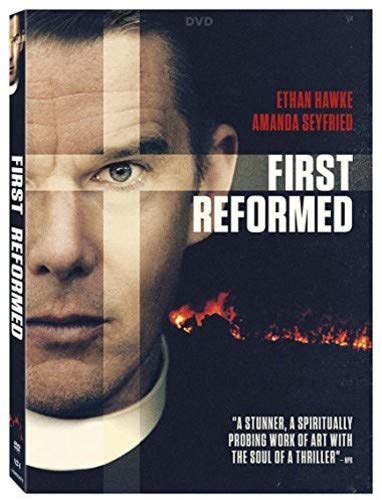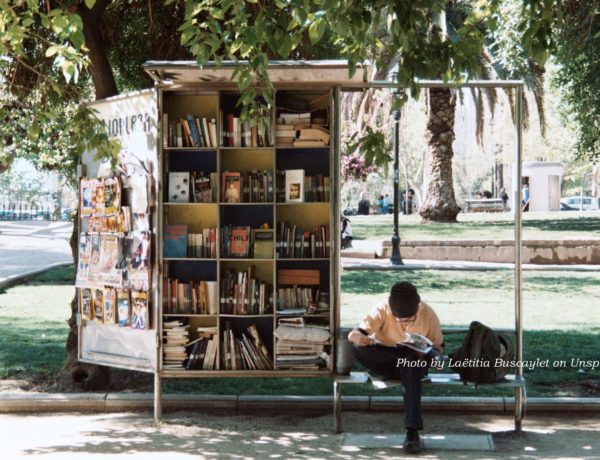First Reformed, a 2017 release written and directed by Paul Schrader. The film stars Ethan Hawke, Amanda Seyfried, and Cedric Kyles. It was chosen as one of the top 10 films of 2018 by the National Board of Review and the American Film Institute. As a well-crafted piece of cinematic art, the movie delivers more questions than answers. Sometimes those are the best experiences, the ones most needed.
Without giving way to spoilers, the basic plot involves a protestant pastor, the Reverend Toller, officiating at a historical church in Snowbridge, New York. The building is soon to celebrate 250 years since founding. The church’s history as a part of the underground railroad that helped escaped slaves on their way to Canada draws some traffic as a tourist attraction. It has been restored a few times through the years. The church is owned and supported by the neighboring mega-church, Abundant Life.
Pastor Toller comes to the tiny congregation with many burdens. He is a retired military chaplain who encouraged his son to follow the family tradition and join the military only to lose him in Iraq. His marriage then fell apart and he is now suffering from depression and alcoholism. His health is failing and at the insistence of those who care about him at Abundant Life, he reluctantly seeks medical advice. His doctor reveals that he is suffering from stomach cancer. Toller is a pain looking for a place to ache. He starts a journal and vows to destroy it in one year’s time. The journal haunts him. Sometimes it is too honest, sometimes it rants and raves. At least once he must destroy some of pages written in the darkest of his hours when he sees himself as delirious.
In his attempt to exist, since living seems beyond his reach, he does connect with one of his few parishioners. A young woman named Mary who is pregnant. She asks him to council her husband because he wants her to have an abortion. Her husband is a radical environmentalist who is terrified of bringing a child into a world spiraling out of control. The husband, Michael, tries to talk with Toller, but nothing seems to give him hope. Mary finds a suicide vest hidden in their garage. When she shows it to Toller, he takes it with a promise to destroy it. He urges her not to call the police because he is afraid she will be drawn into the investigation. The next day Michael shoots himself, unable and unwilling to face what he sees in the world. Mary gives Toller Michael’s laptop so that no one will discover what he was planning.
Here’s where the “no spoilers” dance becomes quite difficult. I think it is easy to see that Michael’s legacy is the irresistible rabbit hole that draws Toller further into his own despair. He sees a spiritual responsibility to care for the earth and finds little support from his superior or the supporters of both churches. Although not sexual in nature, he develops a relationship with Mary. His choices as he is drawn further into the mindset of Michael are the part of the tale that reveal the most about who he has become. The ending is deliberately ambiguous. So much so I was forced to search for alternative interpretations of what happens in the final scene. I discovered that the director wanted an ending that drove audiences to two opposing interpretations in nearly equal numbers. Unsettling to say the least, but, well, I get it.
What I can tell you is that the style of filming is as important as the story line. This is a dark, mostly monotone production, but there are moments of freedom, color, expression. I also think the film gives the viewer space to work out their own darkest secrets and dearest hopes. Toller is faced with serious spiritual and emotional burdens. He has little room to help others but does have compassion in shared agony. Finding passion in the heat of struggle can keep us stable in a world gone insane. That search can also draw us deeper into desperation. Toller takes on Michael’s mission as his own, as his salvation, if you will. The only question is, does it end well, or not?
This film can be a deeply personal film that presents key issues in faith. Do we care about the environment and if so, what should we or can we do to initiate change? In the search for redemption of our own heart and soul, how do we avoid being swallowed up by another’s battle and still possibly help them in their choices? At what point does financial support poison the mission and what can we do to change that? When we do find a human connection that reaches us at our most vulnerable, do we dare let it go?
I hope you check this movie out. Maybe even watch it more than once. But be prepared. It may linger a while and challenge a few ideas you thought you had figured out.




No Comments